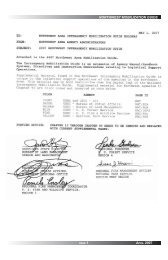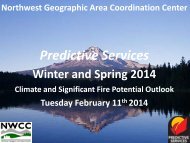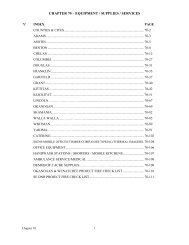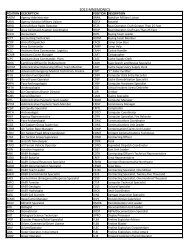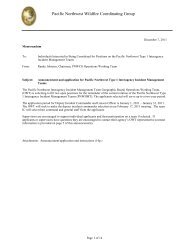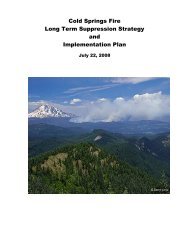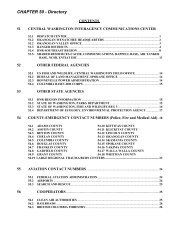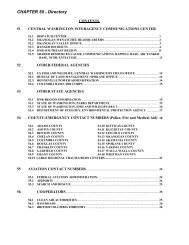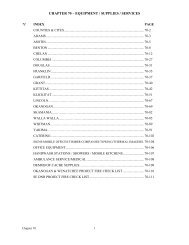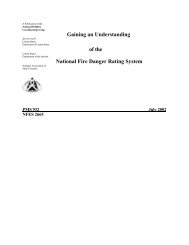Charts for interpreting wildland fire behavior characteristics - NWCC
Charts for interpreting wildland fire behavior characteristics - NWCC
Charts for interpreting wildland fire behavior characteristics - NWCC
You also want an ePaper? Increase the reach of your titles
YUMPU automatically turns print PDFs into web optimized ePapers that Google loves.
THE AUTHORS<br />
PATRICIA L. ANDREWS is a mathematician stat~oned at<br />
the Northern Forest Fire Laboratory in Missoula, Mont.<br />
She rece~ved her B.A. in mathematics and chemistry from<br />
Eastern Montana College, Bill~ngs, in 1970, and her M.A.<br />
in mathematics and computer science in 1973 from the<br />
University of Montana, Missoula. She has been employed<br />
at the Northern Forest Fire Laboratory since 1973.<br />
RICHARD C. ROTHERMEL is a research engineer<br />
stationed at the Northern Forest Fire Laboratory in<br />
Missoula, Mont. Rothermel received his B.S. degree in<br />
aeronautical engineering at the University of Washington,<br />
Seattle, in 1953. He served in the U.S. Air Force as a<br />
special weapons aircraft development officer from<br />
1953-55. Upon his discharge he was employed at Douglas<br />
Aircraft Company as a designer and troubleshooter in the<br />
Armarnent Group. From 1957 to 1961 Rothermel was em-<br />
ployed by General Electric Co. in the aircraft nuclear pro-<br />
pulsion department at the National Reactor Testing<br />
Station in Idaho. In 1961, Rothermel joined the Northern<br />
Forest Fire Laboratory where he has been engaged in<br />
research on the mechanisms of <strong>fire</strong> spread. He received<br />
his master's degree in mechanical engineering at the<br />
University of Colorado, Fort Collins, in 1971. He was<br />
project leader of the Fire Fundamentals research work<br />
unit from 1966 until 1979, and is currently project leader<br />
of the Fire Behavior research work unit at the <strong>fire</strong><br />
laboratory.<br />
RESEARCH SUMMARY<br />
The <strong>fire</strong> <strong>characteristics</strong> chart is proposed as a<br />
graphical method of presenting two primary character-<br />
istics of <strong>fire</strong> <strong>behavior</strong>: spread rate and intensity. Its<br />
primary use is communicating and <strong>interpreting</strong> either site-<br />
specific predictions of <strong>fire</strong> <strong>behavior</strong> or National Fire-<br />
Danger Rating System (NF3RS) indexes and components.<br />
Rate of spread, heat per unit area, flame length, and<br />
<strong>fire</strong>line intensity are plotted on a <strong>fire</strong> <strong>behavior</strong> chart.<br />
Spread component, energy release component, and<br />
burning index are plotted on an NFDRS chart.<br />
Specific examples illustrate use of a <strong>fire</strong> <strong>characteristics</strong><br />
chart in conjunction with <strong>fire</strong> prescriptions, <strong>fire</strong> <strong>behavior</strong><br />
<strong>for</strong>ecasts, <strong>fire</strong> .management plans, and briefings.<br />
The equations used in creating the charts are given;<br />
and a method of obtaining heat per unit area from <strong>fire</strong><br />
<strong>behavior</strong> nomograms is illustrated.<br />
The use of trade, firm, or corporation names in this publication is <strong>for</strong> the<br />
in<strong>for</strong>mation and convenience of the reader. Such use does not constitute an<br />
official endorsement or approval by the U.S. Department of Agriculture of any<br />
product or service to the exclusion of others which may be suitable.<br />
Approved <strong>for</strong> publication by Intermountain Station<br />
September 1981




